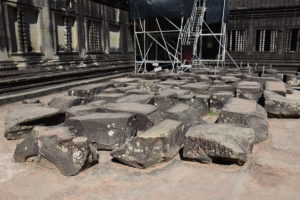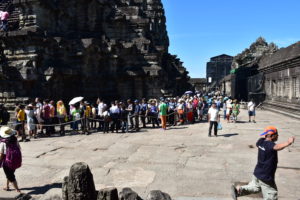Unfortunately, not much is known regards India, its extremely rich cultural heritage, its golden past and even its colourful present beyond the snake charmers, the sadhus and now Info-Tech. If we, however, try and take a closer deeper peek, reality may well be quite different.
Upon gaining independence, the greed for materialistic pleasures became so intense that the exploding population which had tasted freedom for the first time since millennia, left itself with no time or inclination for matters delicate or cerebral. The ensuing generations went even further. The value system that was once a beacon of morality & principles, got irreparably eroded. The newer generations know next to nothing of the rich heritages left by our forefathers and care even lesser for the upkeep & well-being of these peerless monuments. Some governmental efforts, steeped in  corruption though, have been made over the past decades but the outcomes have been very feeble, just as is the case at Angkor, though UNESCO has taken it upon itself to look after Angkor; alas, with little success.
corruption though, have been made over the past decades but the outcomes have been very feeble, just as is the case at Angkor, though UNESCO has taken it upon itself to look after Angkor; alas, with little success.
Masterpieces created in England, Germany, Italy, Greece, France or the Vatican are of comparatively more recent era; 12th century CE onwards. Through the Vedas & Shastras, art & architecture have all been in existence since human himself. There are enough evidences of these having been created in more recent times as well. In the modern hum an history, especially in the Sub-continental India, The Vaishnavi and Shaivite traditions have enabled people lead fulfilled lives. In order to leave important imprints on time and for posterity, monuments were created by generations following those teachings contained in the Holy Scriptures; the Cosmic Principles.
an history, especially in the Sub-continental India, The Vaishnavi and Shaivite traditions have enabled people lead fulfilled lives. In order to leave important imprints on time and for posterity, monuments were created by generations following those teachings contained in the Holy Scriptures; the Cosmic Principles.
Besides the Vaishnavi & shaivite traditions, what was begun from the times of the Mauryan empire, spread in all directions in the 4th Century BCE onwards through the teachings of Buddhism, especially by Emperor Ashoka. The Tibet, China, Indo-China and West Asia, all saw changes in the lives of peoples; some slowly while others at faster pace.
Kings were mighty people and owned the riches of the lands they controlled. Through the sages & seers, they would keep themselves abreast of what is needed to be done for the welfare & well-being of their subjects.  They also knew it well enough that God remained the greatest mooring for humanity, irrespective of their religious or personal beliefs. No one, though, has ever seen God, but all revere The God and turn to him in times of need or distress.
They also knew it well enough that God remained the greatest mooring for humanity, irrespective of their religious or personal beliefs. No one, though, has ever seen God, but all revere The God and turn to him in times of need or distress.
Apparently to meet that internal need of the humans, temples, mosques, churches and cathedrals were made. Everyone goes there to seek solace, peace and blessings of The Lord. These places of worship have been made by people of great motivation, wherewithal and influence on the society.
Angkor and many such temples in India, Thailand, Afghanistan, Tibet, Laos, Vietnam, Myanmar, Sri lanka and Indonesia et el are a result of goodness done by respective kings of bygone era. They would create these temples as mark of a significant victory over the adversary, anointing of a new king or such like important events. There were and still are strict regimens to follow for creating such stellar examples of creativity and art & architecture.
Though the mighty kings such as Ashoka, the Pallavas, Cholas, the Chalukyas in India or the Khmer kings in Cambodia and many others elsewhere, envisioned & funded creation of these masterpieces, those who did the work were the true unsung heros. Only they could have performed these unsurpassed feats of construction medieval times of non-availability of moderns means that we today possess.
India is blessed with numerous such magical monuments, especially in the southern peninsula, from where perhaps the artisans were imported into far east to create the magnificent Angkor. Be these the Barabar Caves in the Jehanabad, Bihar, the Stupa a t Sanchi, Rani Ka Vav at Patan, the Gangaikonda or Rameshwaram Temples in Tamilnadu, all of these spell rich historical backgrounds and are rare pieces of cosmic architecture.
t Sanchi, Rani Ka Vav at Patan, the Gangaikonda or Rameshwaram Temples in Tamilnadu, all of these spell rich historical backgrounds and are rare pieces of cosmic architecture.
There are many even more celebrated ones as the Thiruvananthapuram temple, arguably the richest religious place in the world where at least one of the vaults cannot be opened without a specific vedic chant which may not be known to anyone at present. As per belief this vault alone contains invaluable jewels. Or the Brihadeeshwara Temple at Tanjore, the Shore Temple of Mahabalipuram where there are visual proofs of students having gone through hard grind to learn the art of sculpting from gurus who had passed it down through oral instructions.
Then the masterpiece of The Kailashnath Temple at Ellora, evidently seeing which, the main architect himself after its completion, is said to have exclaimed with ‘really I made this beautiful sculpture?’.
All the names cannot be accommodated here. But the relevance of all and many more of these magnificent architectural wonders gets accentuated by one fact – these are all result of the tenets of the Celestial or Cosmic Architecture.
Celestial architecture takes into account numerous aspects of creating a building such as the vastu-purusha-mandala, timing of construction, the earth, the site, water, wind, flora & fauna, religious rituals and so on. The end result is that such a marvel gets created which serves not only the humanity of generations to follow, but The Lord Himself whose abode it becomes. This place becomes a magnet where humanity of all faiths reaches through a Pilgrimage due to the continuously emanating attraction of The Lord. They come there to attain inner peace, tranquility and knowledge. Knowledge for release from all things evil, through a pilgrimage.
not only the humanity of generations to follow, but The Lord Himself whose abode it becomes. This place becomes a magnet where humanity of all faiths reaches through a Pilgrimage due to the continuously emanating attraction of The Lord. They come there to attain inner peace, tranquility and knowledge. Knowledge for release from all things evil, through a pilgrimage.